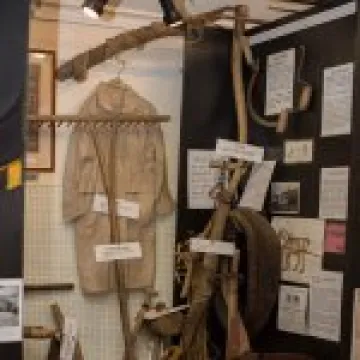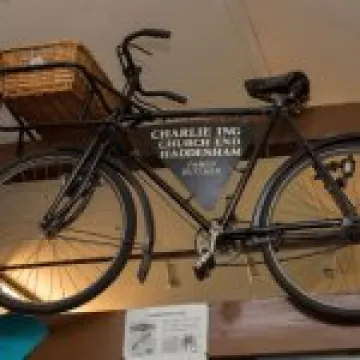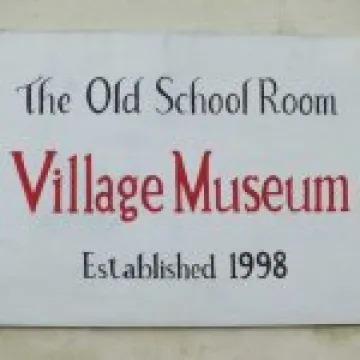Museum
Haddenham
Museum
The museum is a fascinating place to visit, and is the ideal 'visitor attraction' if you happen to be in the village of Haddenham on a Tuesday morning or Sunday afternoon. It's also popular with local residents when they have friends and relatives visiting on those days, as it provides a highly engaging and shared activity as well as an absorbing glimpse of former times in this delightful part of rural Buckinghamshire.
If you've not yet discovered the Haddenham Museum, it is housed in the Old Schoolroom behind the Methodist Church in the High Street. The post code for satnav is HP17 8ES.
See a video presentation here
The museum is open throughout most of the year on Tuesdays, from 10am – 12 noon, and on Sundays from 2.00pm – 4.30pm. (NB: It is closed in January & February, to reduce heating costs). The opening times on Tuesday correspond with the coffee morning in the adjoining Methodist Church, to which visitors are most welcome.
Entry to the museum is free.
The purpose of the museum is to illustrate the history of the village of Haddenham. There are displays of artefacts, albums of photographs, books on local topics, and publications for sale. DVDs about Haddenham are shown on a large screen and some sound recordings can be played on request.
The museum is pleased to publish an annual booklet called The Haddenham Chronicles, which now runs to nine issues – each packed with a wealth of interesting information. Over thirty contributors have written articles for the series on a variety of local history topics. All back issues are available for sale. For further information, please contact Steve Sharp (Tel: 01844 290597 Email: stephsharp@aol.com )
Organisation
The Haddenham Museum Trust is a registered charity. It was established in 1998 and is entirely independent. Membership of the trust has an annual subscription of just £5, thanks to the strong support by the village and by friends from elsewhere. Members receive a discount on most of the items for sale. They also receive a newsletter three times a year to keep them informed of forthcoming events and acquisitions.
The trust has ten committee members and about thirty stewards. A duty trustee opens and closes the museum on each occasion and two duty stewards look after the visitors.
There is an event book in the museum and visitors can ask to be contacted if they want more information than is available at the time. Donations are gratefully accepted. The museum is always keen to recruit new members and stewards to keep the numbers up.
Group Activities
The museum is pleased to welcome group visits at other times by arrangement. The organisation can also arrange talks, slideshows, and guided walks around the village. Please contact Michael Whitney (Tel: 01844 290791 or Alan Rose (Tel: 01844 291004). The museum also puts on an annual slideshow in the Methodist Church.
Other Visitor Attractions in Haddenham
As well as the museum, there is much more to enjoy in the village of Haddenham. It has a large conservation area with winding lanes and alleys and several ponds and greens. The parish church is always open, and the classic English green and pond is a favourite spot for young children to feed the ducks. There are also numerous cafes, restaurants and pubs, offering food and refreshments to sustain and delight visitors. There is still a Post Office and there are numerous village shops and a large Garden Centre, which also offers food and refreshments. If you fancy a rural walk, there are several marked fieldpaths local to Haddenham, and an attractive nature reserve, known as Snakemoor, which is located within a very short walking distance of the village railway station (Haddenham & Thame Parkway). There's also a visitor centre at St Tiggywinkles Wildlife Hospital. Information on all this can be found at the museum, as well as on this community website, of course!
Local History at Haddenham Museum
The museum is dedicated to the local history of the village. Haddenham is a special place to its residents, of course, but its past is also of interest to people from everywhere as we share so much experience. England was once ruled by the Romans and like elsewhere traces of their occupation are still found in our locality. Some finds are displayed in the museum.
All regions of Britain were affected by the world wars, and we show some of the effects on the local populace. The museum also highlights the development of technology, not only in the factories and farms but also in terms of household appliances and domestic entertainment systems. The museum is full of articles and descriptions that will remind you of times past.
Haddenham used to be an agricultural community and it is this aspect of village life that has changed the most. The step change began with the Enclosure in the 1830s, when the common open fields were divided into the private hedged enclosures of today. This was also at the time of rapid development of farming machinery and that caused yet more acceleration in the change of life. At one time all local residents were associated with working the three thousand acres of the parish. Nowadays the number could be counted on one hand. The museum looks back to the village's agricultural past, as well as showing how it grew into a modern thriving community.
The population of the village declined from 1850 and didn't regain its size for a hundred years. People emigrated in the face of unemployment and the museum has often welcomed visitors from the north and overseas after they had traced their family roots back to those hard times.
But Haddenham experienced good fortune brought by air, rail and road links and the museum shows how it happened. A civilian airport was opened just weeks before the outbreak of war in September 1939, when private flying was banned. The military took over the local airfield and for a short time ran the No 1 Glider Training School. You can see the pictures in the museum. The grass airfield was put to various other uses for the rest of the war but the long-term benefit derived from the factories. After the war the airport was not developed but its factories became the hub of an industrial estate that has continued to grow and provide employment. The development is illustrated in the museum.
The railway brought good fortune twice. The first time was at the end of the nineteenth century when it was declared that Haddenham was to be an important stop on a main line from London to Birmingham. The station opened in 1905 and gave new life to the village. The event is celebrated in the museum. The station was closed by the Beeching cuts in the sixties but by that time the motor car was king and even in the village there were three garages. Haddenham was now a popular place to live and it tripled in size in a generation. So much so that a railway station became viable again and a new one was opened in 1987. This event is also celebrated in the museum.
But we still treasure our past and there is a large conservation area that is carefully guarded.
Haddenham is well known for its witchert buildings and the high garden walls constructed of the same material. The name is thought to have derived from 'white earth' as a description of the sub-soil of decayed limestone that is peculiar to this area. It handles like clay and when mixed with straw and water it becomes a durable building material. The museum has collected information on all aspects of witchert.
We look forward to your visit and support.
Alan Rose.





